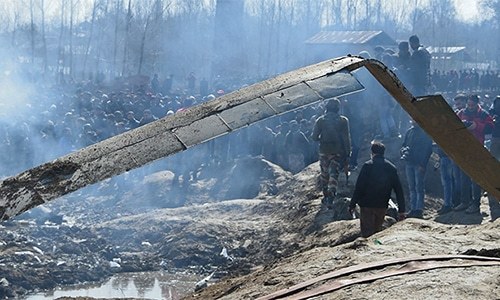Irrelevant whether Indian planes that violated LoC were targeted by F-16s or JF-17s: ISPR

The military's media wing on Monday said that it was meaningless to question whether Pakistan used JF-17 Thunder aircraft or US-built F-16 jets to shoot down two Indian Air Force (IAF) warplanes that violated Pakistani airspace on February 27, saying Pakistan has the right to use any of its abilities for self-defence.
The Inter-Services Public Relations (ISPR) in its statement sought to address repeated claims by the Indian government and media that the Pakistan Air Force (PAF) had used F-16 jets in the dogfight with Indian aircraft and that a Pakistani F-16 jet was shot down by Indian pilots.
"The February 27 incident has become a part of history now," the ISPR statement said, reiterating that no PAF F-16 was hit by Indian forces.
It explained that PAF JF-17 Thunders jets had carried out strikes across the Line of Control (LoC) that day from inside the Pakistani airspace, in response to the Indian strikes in Balakot a day earlier.
Later, when two Indian jets violated the LoC after the Pakistani strikes, they were shot down by the PAF.
"Whether it was F-16 or JF-17 which shot down 2 Indian aircraft is immaterial," the military's media wing said.
"When the Indian planes crossed [the LoC] all of PAF's airplanes including F-16s were airborne," it added.
Read: Deal allows Pakistan to use F-16s as ‘deterrence against India’
The ISPR emphasised that India could "assume any type of their choice [of the PAF jets]" but that would not change the end result of the dogfight that took place in February.
"Even if F-16[s] have been used ... the fact remains that Pakistan Airforce shot down two Indian jets in self-defence," it said.
"Pakistan retains the right to use anything and everything in its legitimate self-defence."
Following the conflict between the two countries in February, India had claimed that the PAF had used the F-16 warplane to target Indian military installations after crossing the LoC. For “proof” a piece of an apparent missile was shown, which the Indian media said could only have been used by an F-16.
It also claimed that before an Indian plane was shot down and its pilot captured by Pakistani forces, an IAF MiG Bison had shot down a PAF F-16 aircraft. Pakistan had denied the Indian claims.
New Delhi had insisted that Pakistan’s alleged use of F-16 against India meant that Islamabad stood in violation of a sales agreement with the US.
The US State Department had refused to take a position on India's complaint against Pakistan over using F-16s in the air battle. However, Dawn had reported last month that Washington while providing F-16 fighter jets to Islamabad not only acknowledged the aircraft’s “deterrence value” to Pakistan in a future conflict with India but also noted that it could prevent a nuclear clash between the two neighbours.
Also, New York Times journalist Maria Abi-Habib had quoted US sources as saying "if India entered Pakistani airspace for a second day, and Pakistan used the [F-16] jet defensively, the contract wasn’t violated. But, if Pakistan used an F-16 to attack India first, then deal was violated.”
The ISPR statement comes two days after India reportedly shared "critical evidence" with the US that the PAF had used F-16 fighters to strike targets in Indian-occupied Jammu and Kashmir, according to a Hindustan Times report.
Quoting unnamed government officials, the newspaper said India had shared evidence, including call signs associated with PAF F-16s and "specific details" of the AIM-120-C5 Advanced Medium Range Air-to-Air Missile (AMRAAMs) which New Delhi alleged Pakistan had used, with the US through "institutionalised intelligence channels".













































